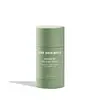What's inside
What's inside
 Key Ingredients
Key Ingredients

 Benefits
Benefits

 Concerns
Concerns

No concerns
 Ingredients Side-by-side
Ingredients Side-by-side

Water
Skin ConditioningKaolin
AbrasiveButylene Glycol
HumectantGlycerin
HumectantPropylene Glycol
HumectantDiatomaceous Earth
AbrasiveSodium Stearate
CleansingTitanium Dioxide
Cosmetic ColorantPEG-8
HumectantVp/Va Copolymer
CI 77288
Cosmetic ColorantSilica
AbrasiveCharcoal
AbrasiveCI 77492
Cosmetic ColorantMica
Cosmetic ColorantAlumina
AbrasiveChlorphenesin
AntimicrobialNiacinamide
SmoothingSalicylic Acid
MaskingArtemisia Argyi Leaf Extract
Skin ConditioningParfum
MaskingMenthol
MaskingCentella Asiatica Extract
CleansingPropanediol
Solvent1,2-Hexanediol
Skin ConditioningZinc PCA
HumectantNymphaea Caerulea Flower Water
Skin ConditioningLactobacillus/Rice Ferment
Skin ConditioningSalix Alba Bark Extract
AstringentBisabolol
MaskingPropolis Extract
Skin ConditioningCalendula Officinalis Flower Extract
MaskingCaprylhydroxamic Acid
Water, Kaolin, Butylene Glycol, Glycerin, Propylene Glycol, Diatomaceous Earth, Sodium Stearate, Titanium Dioxide, PEG-8, Vp/Va Copolymer, CI 77288, Silica, Charcoal, CI 77492, Mica, Alumina, Chlorphenesin, Niacinamide, Salicylic Acid, Artemisia Argyi Leaf Extract, Parfum, Menthol, Centella Asiatica Extract, Propanediol, 1,2-Hexanediol, Zinc PCA, Nymphaea Caerulea Flower Water, Lactobacillus/Rice Ferment, Salix Alba Bark Extract, Bisabolol, Propolis Extract, Calendula Officinalis Flower Extract, Caprylhydroxamic Acid
 Reviews
Reviews

Ingredients Explained
These ingredients are found in both products.
Ingredients higher up in an ingredient list are typically present in a larger amount.
Kaolin is a clay. It is used for oil control and to help minimize pores. Like other clays, kaolin has the ability to absorb excess sebum or oil. This can help clean out pores and mattify the skin.
Some types of kaolin may have exfoliating properties. When water is added to kaolin, it becomes a paste with small abrasive particles.
Most kaolin is a white color, but may be pink/orange/red depending on where it comes from.
The name 'kaolin' comes from a Chinese village named 'Gaoling'. Kaolin clay comes from rocks rich in kaolinite. Kaolinite, the mineral, has a silicate layered structure. Kaolinite is formed from chemical weathering of aluminum siilicate minerals.
Besides skincare, kaolin is commonly used to make glossy paper, in ceramics, toothpaste, and as medicine to soothe stomach issues.
Learn more about Kaolin